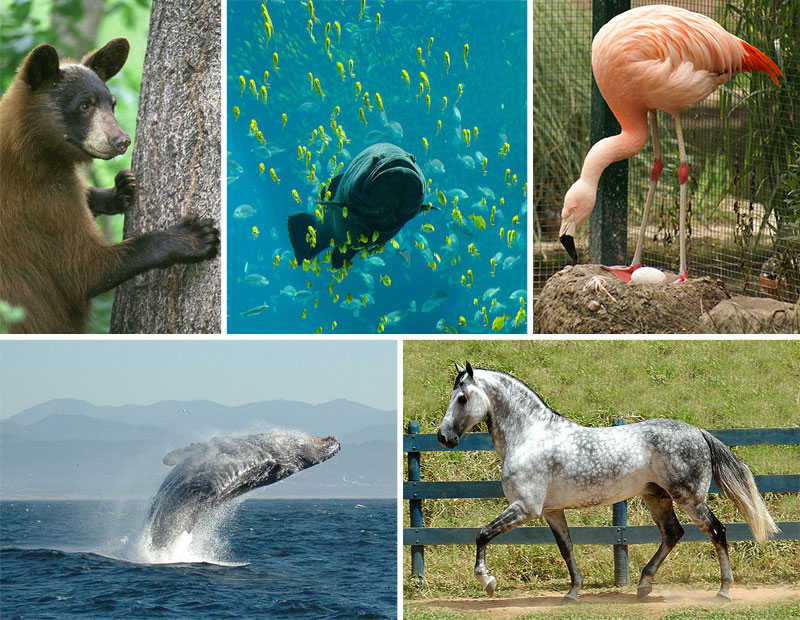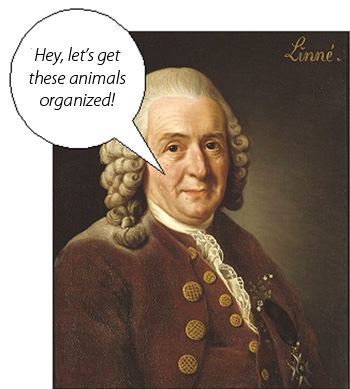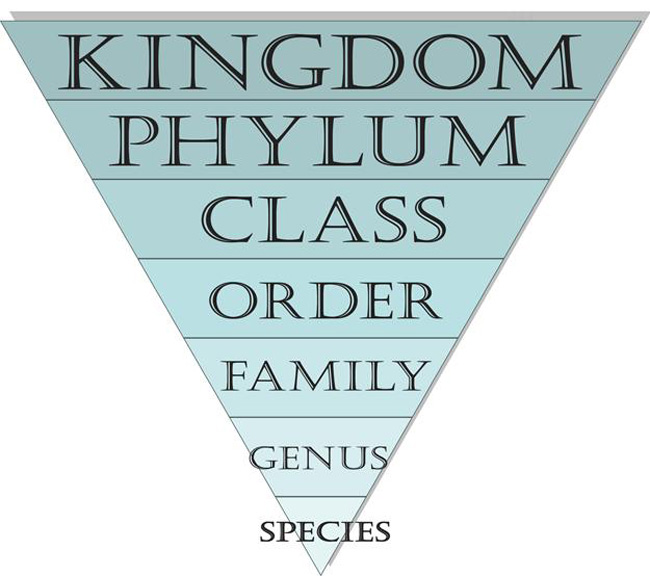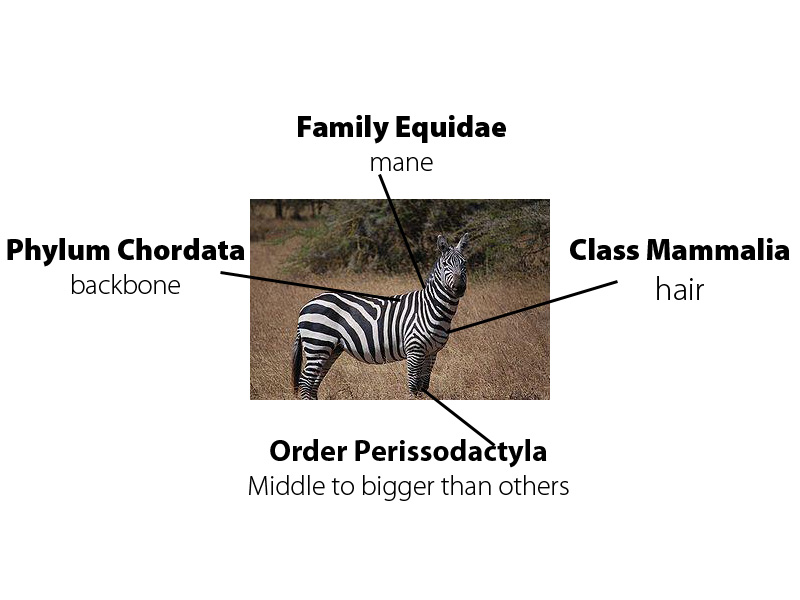To How Many Families Can a Specific Genus Belong
Introduction
This lesson explores the classification system used to identify animals. Near children are fascinated by animals and ofttimes have an animal that is a item favorite, possibly fifty-fifty an animal the child has never seen before. Children also like to social club and sort things, and this lesson melds both of these interests.
This lesson is specifically designed to motility quickly across the knowledge level to high-level thinking. This lesson can be taught to an entire classroom or given as a self-directed extension activeness.
Learning Objectives
After completing the lessons in this unit, students will exist able to:
- Know and understand the seven levels of nomenclature.
- Utilize that knowledge as they practice classifying animals.
- Evaluate and compare the classification of animals.
- Devise a nomenclature organisation for the objects in their homes.
- Create a new species and classify information technology according to the principles of classification.
Grooming
- Print the lesson plan on a color printer.
- Accept admission to the Internet for pupil(s).
- Gather supplies including paper, pen or pencil, crayons, colored pencils and/or fine-tip markers.
Lesson 1: Ancestry
Look at the pictures of these animals, then fill up in the chart below: (We've given you lot an example.)


Choose the two animals from your nautical chart that you think are virtually like and justify your choice in one judgement.
Lesson 2: Organizing the animals — how information technology happened

Dorsum in the 18th century, a Swedish man named Carolus Linnaeus thought it was important to organize living things, and he developed a organisation to do just that. He started out interested in plants, merely he ended upward ordering all life every bit he knew it. We still use the essence of his system today. Scientists are constantly refining the system based on new noesis. Who knows? Maybe y'all will make a change in how animals are organized!
Putting animals in order like this is called taxonomy. The taxonomists — people who name animals — employ a volume called the International Lawmaking of Zoological Nomenclature, or ICZN, to tell them the rules for classifying animals.
Linnaeus's system has vii levels:
- Kingdom
- Phylum
- Class
- Order
- Family unit
- Genus
- Species
Every animal on the planet, down to the about microscopic animal yous can imagine, can be classified co-ordinate to this arrangement. You can remember the order the system comes in with i of the following phrases. The first alphabetic character of each word is the first letter of the alphabet of the level of classification. Selection the ane you lot similar the all-time and practise proverb it five times.
Chiliading Phillip, come out, for goodness' sake!
King penguins congregate onorth frozen ground sometimes.
Keep ponds clean or frogs get sick.

Let's wait at each level and an case using one mutual animal.
These levels commencement out broadly — that means the superlative levels take the most animals, and they get narrower and narrower as y'all go down. And so, by the time you lot go to the species, there is only one animal in the grouping. Yous can imagine these levels as an upside-down triangle.
- Kingdom
- Generally, scientists agree at that place are six kingdoms. The animal kingdom (called Kingdom Animalia) is just one of those. In case y'all're interested, the others are Achaebacteria, Eubacteria, Protists, Fungi and Plants. Originally, Linnaeus but identified two kingdoms: establish and animal. Some scientists recall that viruses should take their ain kingdom, only currently they are not included under this system.
- Phylum
- Inside the beast kingdom, the animals are divided into more than xxx phyla (which is the plural of "phylum"). You might exist interested in Phylum Chordata — information technology's the one humans and all animals with backbones are in (do you run into how "chordata" looks like the word "string" — like spinal cord?). Phylum Arthropoda contains insects, spiders and other animals with segmented bodies, similar shrimp. Arthropods take their skeletons on the exterior of their bodies (call back of the hard vanquish of a lobster) and other characteristics in common.
- Form
- The third level of nomenclature is class. For example, Phylum Chordata has classes in information technology like birds, mammals (Mammalia) and reptiles.
- Order
- The next level, or rank, is guild. Orders are smaller groups within the different classes. Lepidoptera is the order of moths and butterflies. Carnivora is the order within Mammalia that has the virtually diversity in creature size.
- Family
- The 5th rank of classification is family. (When you get to this rank, people sometimes disagree almost which family an fauna belongs to, and so you may find that different sources tell you unlike things. This tin can fifty-fifty happen with orders.) The family unit for dogs is Canidae.
- Genus
- This rank looks like "genius," doesn't it? It'due south the second-to-last rank, and a genus may have just one or two animals in it. If animals are in the same genus, they are really closely related. In fact, you may non be able to tell them apart just by looking at them! When we write the name of the genus, we capitalize it and italicize it. For instance, the genus of dogs (and wolves, too!) is Canis.
- Species
- If animals can breed together successfully, they are a species. When an brute is called past its scientific name, and so that means information technology is beingness identified by its genus and species. We use a lowercase letter of the alphabet and italics for the species. The scientific proper name of dogs is Canis familiaris; notwithstanding, the scientific proper noun of wolves is Canis lupus.
Lesson three: Using what yous've learned
Wait dorsum at your chart of the animals that y'all did in Lesson i. Let's see how they fit into what we've just learned. Using that chart and the chart on the last page of this lesson, respond the following questions:

- Why practice you recollect we left Kingdom off of the nautical chart? What kingdom does each of these animals belong to?
- Expect at the class of the Chilean flamingo. All birds vest to that course. Exercise you lot see why nosotros telephone call things to do with airplanes "aviation?" Using that same idea, and looking at the order of the bluish whale, can you brand upwardly a word that ways "as big as a whale?"
- Exercise you agree or disagree with this argument? If two animals are the same genus, and so they must likewise exist the aforementioned family unit, lodge, class, phylum and kingdom. Why did you lot make that pick?
- Why exercise you lot call back that we had to be more specific about the animals in this chart? Why can't nosotros just put "bear"? Why did we have to say "grizzly bear?"
- Whales really accept suborders depending on whether they have teeth or baleen (comblike sieves that let water out but keep their food in). Remember about the name of the kind of dr. who puts braces on people's teeth. Now think about the proper noun of the whale suborder Odontoceti. Do yous call up these are whales with teeth or whales with baleen?
- The family that horses vest to, Perissodactyla, means "odd toed." Think most what a horse'due south hoof looks like. Can you recall of any other animals non on this chart that might belong to that family?
- Using the chart to a higher place, write the scientific names of the cow, the flamingo and the whale.
- Cow
- Chilean flamingo
- Blue whale
Did y'all put the genus first with a upper-case letter? Proficient for y'all! When you see a species' name written, it will be the genus and the species, so the scientific proper name is sometimes only chosen "species." Sometimes the genus will only be listed as a capital alphabetic character with a period subsequently it, similar this: B. muscle.
Lesson four: Working with your favorite fauna
Become to the University of Michigan Museum of Zoology's Animal Multifariousness Web. In the search box, put in your favorite animal. Now write out its classification:
- Kingdom: _______________
- Phylum: _______________
- Class: _______________
- Order: _______________
- Family: _______________
- Genus: _______________
- Species: _______________
Look on the chart of animals in the previous lesson. Are there whatsoever animals on the nautical chart in the same phylum as your animal? Same course? Which brute exercise you think is the nearly closely related to your animal?
Go back to the website and endeavor to think of a few animals that would be very closely related to the first animal you chose and classified in a higher place. For example, if you chose "tiger," effort "lion" and "panther." How close can y'all become? Can you lot become down to the same family unit? How about genus?
What animal could yous find that was closest to yours?
Lesson 5: Classifying your firm
It's not only animals that get organized. Think almost the grocery store; is the cereal in the same area as the fruit? No, each type of food is in its own infinite. You can easily tell how the grocery store classifies its items for sale by looking at the signs above the aisles.
Now call back about your house. Imagine that you needed to allocate every detail in your firm. One way would be to use the ideas that Linnaeus had — to start out with wide categories and get narrower. Let'due south try information technology!
You are going to devise a vii-level organization for classifying the things in your house. If you get confused at whatsoever fourth dimension as you are doing this, you can look at the examples listed afterward in the lesson.







- Start, let's think about the broadest level. Is everything within your firm or do you accept some things exterior, likewise? Maybe your first level needs to be the Kingdom Inside and the Kingdom Outside. If your family has other places that you keep things you lot ain (like a separate business firm or a storage unit), that might be a third kingdom. You may want to take kingdoms based on sides of the business firm or things for parents and things for kids. Listing your kingdoms.
- Next, you demand the next level down, phylum. Retrieve about the things y'all have in i of your kingdoms. Tin can you lot think of a few categories you could split up them into? You may want to choose phyla based on rooms (such as Phylum Living Room, Phylum Kitchen). You may want to choose phyla based on the items' size or what they are made of. It's up to you. Choose just 1 kingdom from your list in a higher place and create 3 phyla for it on the side by side page (remember that phyla is the plural of phylum).
- Pick i of the iii phyla you created higher up and put it on the line below. Write the kingdom that phylum belongs to on the line adjacent to Kingdom. Remember most the phylum you lot picked. In your listen, pause it down into some categories. For example, if your phyla were broken down by rooms, and you picked "Living Room" every bit your phylum, how could you dissever the things in your living room into categories? Could you break them down by what y'all do with them? How well-nigh who uses them? How about what they are made of or where they are (wall, floor, closet)? Don't endeavor to brand the categories too small, because y'all take several levels left! These categories are your classes. Think of three classes and list them on the diagram beneath:
- Now you are going to echo this until yous get to species. After class comes order (remember your sentence!), then choose 1 class from in a higher place, listing in on the line below and create three orders to go underneath it. Just continue thinking about how you could narrow that grouping of things even more. Remember to wait at the example at the stop of this section if you get stuck. List the kingdom and phylum, also, so you can proceed track.
- You simply take a few levels to become! Afterwards gild comes family, so choose i of your orders from above and do the aforementioned thing yous've been doing. Break it down into smaller categories.
- You merely have two levels left! Y'all are about to a single item! Wow! Choose one family from your list above and then break it downwardly into three smaller groups. Remember that the side by side level will be an individual particular, and so be sure to brand the genera (that'south plural for more than than one genus) very narrow.
- You are at the last footstep! You are downwardly to individual items! Choose a genus from your listing above, and proper name three unlike species, or items, within that genus.
- Now choose one of your species listed to a higher place and list its entire scientific classification from kingdom on downwardly:
Examples
Wait here for ideas if you lot get confused. There is an example of how to break things downward into smaller categories, and and so there is an example of a scientific classification for an item. So that you don't get stuck trying to copy the example, we've used a school instead of a business firm for the example.
Practice yous see how the groups go smaller and smaller, ending in a single item? That is what you are trying to do.
| Kingdom: | Classroom |
| Phylum: | Students' Supplies |
| Class: | Language Arts |
| Order: | Reading Heart |
| Family unit: | Books |
| Genus: | Chapter Books |
| Species: | "Tales of a 4th Grade Cipher" |
Here is an example of how one level could be cleaved downwards into several smaller categories. Nosotros'll apply the level family unit from in a higher place for our example. Notice how each genus is a smaller function of the family of Books.

Lesson 6: Create and allocate your own animal
Imagine that you are a biologist studying animals in the wild. I day, while lying in your viewing spot, yous see an fauna you accept never seen before. You rush back to your tent and look through your encyclopedia of animals, growing more and more excited equally you realize that you accept discovered a new species! Equally the discoverer of this new species, you get the honor of naming it. Of class, being a fantastic scientist, you will follow the classification system in identify. That means that the simply part of the animate being's name you volition make up yourself is the actual species proper name.
You become back to the Animal Diversity Web to detect the closest beast you can observe to the one you lot discovered. For example, if the animal you accept discovered looks a lot like a panther, wait up "panther" on the website.
So go a clear movie of your brute in your heed. Is it a mammal? a fish? a bird? This works all-time if you lot create an creature that is similar to your favorite animal you chose earlier, but notwithstanding slightly different. Describe a picture of your new fauna.
Listing the animal'due south classification. Remember, its nomenclature should be the aforementioned every bit the animal you constitute that is almost the same as this i. The only deviation volition be the species.
Wait at several other species within the genus so that yous can think of something that makes your animal slightly different than whatsoever other species in the genus. For case, it could be a different color or eat something different or live on a different continent.
What is your species' distinguishing characteristic?
Subsequently you have classified your animate being, including creating a species proper noun, go dorsum and label your motion-picture show with one thing from each level that is unique to that classification. For case, if your beast is in phylum Chordata, describe a line to the animal'south courage and write, "Phylum Chordata — backbone." Do this for at least four levels. Wait back to the Animal Multifariousness website you lot used earlier to search each of those levels. It volition tell you what characteristics are typical of that classification. You may also use an encyclopedia to aid you lot.
Run into the example below.

Extension
Books on Animals
Because animals nearly universally interest children, there are myriad books on them geared to young readers. Included here are a few high-quality volumes that are distinguished due to quality of illustration, comprehensiveness of material, interest to gifted learners or classic nature.
Nonfiction:
- Animate being: The Definitive Visual Guide to the Earth's Wildlife past David Burnie
- National Geographic Encyclopedia of Animals by Karen McGhee
- The Encyclopedia of Animals: A Complete Visual Guide by George McKay
- A Life in the Wild: George Schaller's Struggle to Save the Last Great Beasts past Pamela Turner
Fiction:
- Mr. Popper's Penguins by Richard Atwater
- The Dr. Dolittle serial by Hugh Lofting
- Charlotte'due south Web, Stuart Picayune and Trumpet of the Swan past E.B. White
Online Data:
- Strong readers may like these articles on problems in biodiversity.
- For students intrigued by these Latin names, check out the Pronunciation of Biological Latin, which explains Latin pronunciation.
Cess
Answers to Lesson 3: Using what you lot've learned
- Why practise you think we left "Kingdom" off of the chart? What kingdom does each of these animals belong to?
Kingdom was left off considering all animals belong to Kingdom Animalia. - Look at the class of the Chilean flamingo. All birds belong to that course. Practice yous see why nosotros call things to practise with airplanes "aviation?" Using that same idea, and looking at the lodge of the blue whale, can you lot make up a discussion that means "as large as a whale?"
Answers will vary, but should include at least the root of "cetacean." - Exercise you agree or disagree with this statement? If ii animals are the same genus, then they must likewise exist the same family unit, guild, grade, phylum and kingdom. Why did you make that pick?
Answers will vary, but the correct respond is "Agree." The classification arrangement is top downwardly, so if the creature is the same equally another at a lower level, they must be in the aforementioned higher levels. - Why exercise you retrieve that we had to be more specific about the animals in this nautical chart? Why can't nosotros just put "bear?" Why did we take to say "grizzly bear?"
Once more, answers will vary, but the key idea is that there is more than one species of bear. - Whales actually have suborders depending on whether they have teeth or baleen. Think most the name of the kind of doc who puts braces on people's teeth. Now think nigh the name of the whale suborder Odontoceti. Do you call up these are whales with teeth or whales with baleen?
Suborder Odontoceti are whales with teeth. - The family that horses belong to, Perissodactyla, means "odd toed." Remember virtually what a horse'southward hoof looks like. Can you think of any other animals not on this chart that might vest to that family unit?
There are many possible answers, including zebras and rhinos. For more data on this club, bank check out the Animal Variety Spider web. - Write the scientific names of the cow, the flamingo and the whale.
Moo-cow: Bos taurus
Chilean flamingo: Phoenicopterus chilensis
Blueish whale: Balaenoptera muscle
Answers to Lesson 4: Working with your favorite creature
The right classification will depend upon the animal chosen. Use either the Creature Diversity Web or any encyclopedia to verify that the student has chosen the right classification.
Rubric for Lesson v: Classifying your firm

Rubric for Lesson six: Creating your ain creature

fitzgeraldfible1997.blogspot.com
Source: https://www.mensaforkids.org/teach/lesson-plans/classifying-animals/
0 Response to "To How Many Families Can a Specific Genus Belong"
Post a Comment